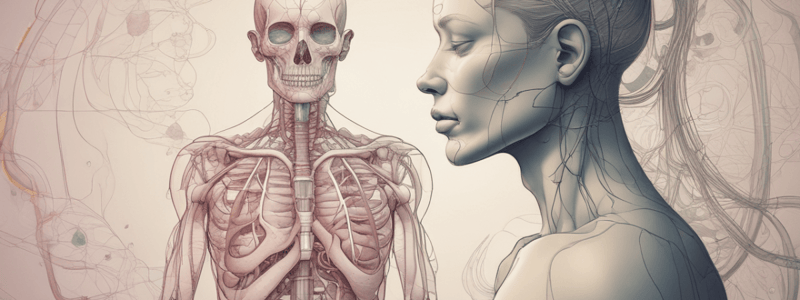Podcast
Questions and Answers
What is the primary role of carbonic anhydrase in the transportation of CO2 in the blood?
What is the primary role of carbonic anhydrase in the transportation of CO2 in the blood?
- To release CO2 from the blood into the lungs
- To facilitate the reaction of CO2 with water to form carbonic acid (correct)
- To regulate the pH of the blood by buffering excess hydrogen ions
- To convert CO2 into oxygen
What is the result of intense exercise on the body's respiratory system?
What is the result of intense exercise on the body's respiratory system?
- Decreased production of carbonic acid
- Impaired oxygenation of tissues, leading to hypoxia (correct)
- Increased oxygenation of tissues
- Increased buffering of excess hydrogen ions
What is the purpose of lung function testing in a pharmacy setting?
What is the purpose of lung function testing in a pharmacy setting?
- To determine the patient's risk of developing respiratory infections
- To assess the patient's overall physical fitness
- To diagnose acute and chronic lung conditions (correct)
- To monitor the effects of medication on lung function
What is the name of the enzyme that facilitates the reaction of CO2 with water to form carbonic acid?
What is the name of the enzyme that facilitates the reaction of CO2 with water to form carbonic acid?
What is the term for the inadequate oxygenation of tissues, resulting in impaired aerobic respiration?
What is the term for the inadequate oxygenation of tissues, resulting in impaired aerobic respiration?
What is the purpose of the bicarbonate buffer system in the blood?
What is the purpose of the bicarbonate buffer system in the blood?
What is the name of the test that measures the percentage of oxygen saturation in the blood?
What is the name of the test that measures the percentage of oxygen saturation in the blood?
What is the result of the reaction of CO2 with water in the presence of carbonic anhydrase?
What is the result of the reaction of CO2 with water in the presence of carbonic anhydrase?
Why is it essential for a pharmacist to understand the importance of gas exchange in the body?
Why is it essential for a pharmacist to understand the importance of gas exchange in the body?
What is the term for the movement of CO2 from the tissues to the lungs?
What is the term for the movement of CO2 from the tissues to the lungs?
Study Notes
The Respiratory System
- The respiratory system has 5 main functions: gas exchange, pH regulation, defense against pulmonary pathogens, vocalization, and facilitating the sense of smell.
Mechanism of Ventilation and Gas Exchange
- Ventilation involves breathing, pulmonary gas exchange, transport of O2 and CO2 by the blood, systemic gas exchange, and stimulation by irritation of the nasal mucosa.
- The 5 stages of respiration are ventilation, pulmonary gas exchange, transport of O2 and CO2, systemic gas exchange, and stimulus.
Control of Ventilation
- The respiratory center regulates breathing, and at rest, about 200 mL of O2 are used each minute by body cells.
- During exercise, O2 use increases 15- to 20-fold in normal healthy adults.
- Chemoreceptors, located in the medulla oblongata and in the aortic and carotid bodies, detect changes in CO2, H+, and O2 levels and modulate ventilation.
Gas Exchange and Respiratory Quotient
- The respiratory quotient (RQ) reflects the ratio of carbon dioxide production to oxygen consumption, depending on the fuel mixture (diet).
- The RQ of carbohydrates is 1, while that of fats and proteins is much lower.
Oxygenation of Blood
- Oxygen has a key role in "aerobic" respiration, and the concentration of hemoglobin (Hb) and partial pressure of oxygen (PaO2) are critical.
- Oxygen saturation of hemoglobin (SaO2) can be measured using a pulse oximeter.
CO2 Transport
- CO2 is transported in three forms: dissolved CO2 (7%), bound to hemoglobin (23%), and as bicarbonate ions (70%).
Gas Exchange and Respiration
- Gas exchange between RBC and tissue involves the key enzyme carbonic anhydrase.
- Respiration controls blood pH through the equation: CO2 + H2O → H2CO3 → H+ + HCO3-.
Clinical Significance
- Hypoxia occurs when tissues receive inadequate O2 to support aerobic respiration, often due to impaired oxygenation or blood supply.
- Lung function testing, including spirometry, FeNO, pulse oximetry, and exercise tolerance tests, are important for pharmacists to understand and implement.
- Understanding respiratory function and pH control is crucial for pharmacists to manage acute and chronic lung conditions.
Studying That Suits You
Use AI to generate personalized quizzes and flashcards to suit your learning preferences.
Related Documents
Description
Test your knowledge on the basic anatomy and functions of the respiratory system, including gas exchange, pH regulation, and defence mechanisms. Learn about the different stages of lectures on respiratory diseases such as asthma and COPD.




